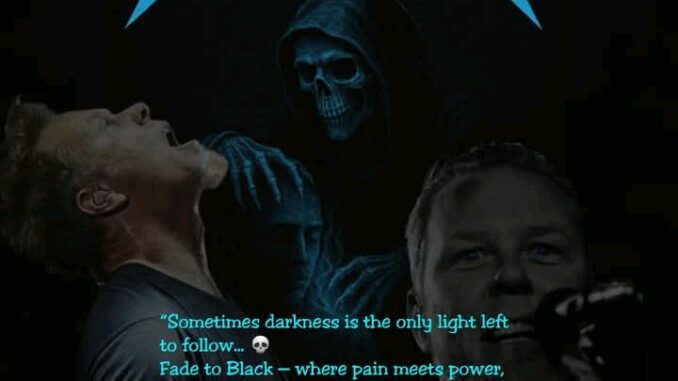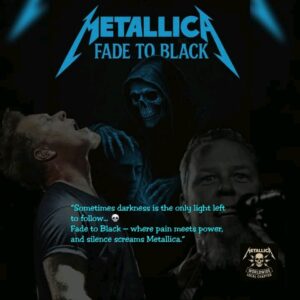
A Song Born from Pain: The Eternal Flame of Metallica’s ‘Fade to Black’..
There are songs that simply exist—catchy, melodic, entertaining for a few fleeting minutes—and then there are songs that endure. Songs that breathe, bleed, and echo through generations because they speak to something deeper than sound. Metallica’s “Fade to Black”, released in 1984 on their groundbreaking album Ride the Lightning, is one of those songs. It was born out of anguish, loss, and despair, yet somehow emerged as one of the most powerful and inspiring anthems in heavy metal history.
What began as a reflection of hopelessness became a declaration of survival—a paradox that defines not only the track itself but the band’s journey through darkness and redemption.
—
The Birth of a Shadow: Inspiration in Despair
In late 1983, Metallica was a young, hungry band clawing its way to recognition. They were touring relentlessly, living on the edge of poverty, and channeling their frustrations into the furious thrash metal sound that would soon define a generation. But amidst that chaos, tragedy struck.
While on tour, their gear—including James Hetfield’s prized Marshall amplifier and guitars—was stolen from their van in Boston. For a band that had little to begin with, the loss was devastating. Hetfield, still only 20 years old, spiraled emotionally. “I felt like everything I worked for was gone,” he later admitted. That despair became the seed for “Fade to Black.”
It wasn’t just about the loss of equipment—it was about a loss of purpose. The song captured the weight of depression, the suffocating darkness of self-doubt, and the haunting feeling of being alone in the world. Yet, out of that shadow came something extraordinary: a song that allowed thousands to find light in their own darkness.

Breaking the Chains: The Sound of Evolution
When “Fade to Black” first hit the airwaves, it shocked fans and critics alike. Metallica—then known for their aggressive speed and thrash—had dared to release a ballad. For many, it was unthinkable. The track opened with a clean, melancholic acoustic guitar—soft, somber, and sorrowful—before building into a torrent of electrified emotion.
The composition represented a turning point not only in Metallica’s musical evolution but also in the genre itself. Before this, heavy metal rarely showed vulnerability. The genre was known for aggression, rebellion, and dominance—but “Fade to Black” introduced introspection, fragility, and emotion without sacrificing power.
Kirk Hammett’s guitar solo, often hailed as one of the greatest in rock history, bleeds raw feeling. It’s not about technical prowess—it’s about storytelling. Each note ascends like a cry for help, echoing the despair of Hetfield’s lyrics before soaring into catharsis. The final solo, cascading into silence, feels like a soul finally finding release.
—
A Farewell to Fear
“Life, it seems, will fade away / Drifting further every day.”
These opening lines struck listeners like a lightning bolt. The lyrics spoke of exhaustion, emptiness, and the slow erosion of willpower—feelings many were too afraid to articulate. At a time when mental health was rarely discussed, Hetfield’s raw honesty was revolutionary.
Yet, “Fade to Black” isn’t an endorsement of despair—it’s a confrontation of it. The song’s title, often mistaken as symbolic of death, actually represents transformation. It’s about confronting darkness and surviving it. The fading to black isn’t the end—it’s the shedding of fear, the acceptance of pain, and the rebirth that follows.
For fans struggling with their own inner battles, the song became a lifeline. Letters poured in from listeners who said “Fade to Black” helped them through depression, heartbreak, and even suicidal thoughts. It became an anthem not of death—but of defiance.
—
The Controversy: When Darkness Meets the Spotlight
Upon its release, “Fade to Black” didn’t escape criticism. Some fans accused Metallica of “selling out” for daring to slow down. Others misinterpreted the song as glorifying suicide. Radio stations even hesitated to play it due to its somber tone and lyrical themes.
But over time, those critics faded away, and the song’s brilliance shone through. The very vulnerability that once seemed out of place in metal became a new pillar of the genre. Bands like Megadeth, Pantera, and later Tool and Slipknot would explore emotional depth in their own music—thanks, in part, to the courage Metallica displayed in “Fade to Black.”
—
On Stage: A Shared Catharsis
Live, “Fade to Black” takes on an entirely different energy. When James Hetfield stands beneath a single spotlight and begins those opening chords, there’s a hush—a sacred silence that falls over thousands of fans. The connection between band and audience becomes palpable.
For decades, Metallica has used the song as both a performance highlight and an emotional anchor. During live shows, the crowd often sings every word in unison, transforming pain into unity. It’s not just a song anymore—it’s a ritual, a moment of collective healing.
The beauty of “Fade to Black” lies in its contradiction: a song about despair that brings hope, a farewell that ignites resilience. It proves that even the darkest emotions can create something profoundly life-affirming.
—
Legacy: The Flame That Never Dies
More than forty years after its release, “Fade to Black” remains one of Metallica’s most beloved tracks. It’s performed at nearly every major concert, has been covered by countless artists, and continues to inspire musicians across genres—from rock and metal to orchestral and acoustic reinterpretations.
Critics often list it among the greatest songs ever written, not only for its musicality but for its emotional honesty. It bridged the gap between heavy metal and human vulnerability, allowing fans to see that strength isn’t just about rage—it’s also about endurance.
The song also stands as a mirror to Metallica’s own evolution. From their turbulent beginnings to their global superstardom, “Fade to Black” remains a reminder of where they came from—and how pain forged their power.
—
Conclusion: The Eternal Light in the Dark
When James Hetfield wrote “Fade to Black,” he could not have known the song would save lives—including perhaps his own. What started as a lament for lost purpose became a symbol of survival, a torch in the dark for anyone who’s ever felt close to giving up.
In the end, “Fade to Black” isn’t just a song about death—it’s about rebirth. It tells us that acknowledging pain doesn’t make us weak; it makes us real. The music may fade, but its message endures—a whisper in the dark reminding us that the flame, no matter how dim, never truly dies.
“A song born from pain, yet it became one of the most powerful anthems in metal history.
‘Fade to Black’ isn’t just music — it’s a farewell to fear, a flame that never dies.”
Leave a Reply